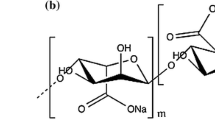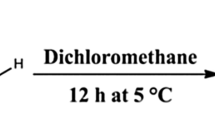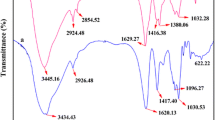Abstract
In this work, pH/temperature dual-sensitive polymers of P(NVCL-co-MAA) with the increased low critical solution temperature (LCST) values of about 37 °C that differed from that of ~ 32 °C of pure poly(N-vinyl caprolactam) (PNVCL) were synthesized via radical polymerization. Then the nanofibers of P(NVCL-co-MAA) and its cospinned nanofibers with nifedipine (NIF) as drug model were fabricated by electrospinning method. Structures and the interactions within the components were detected by FT-IR, NMR, and XPS methods. The dual-responsive properties and the controlling release of the drug were investigated by water contact angle tests and in vitro drug release tested by UV-vis spectrophotometer. SEM was conducted to demonstrate the morphology of the nanofibers and the obvious improved stabilized morphology of the modified system within the aqueous media. The maintained morphology within the media and the obvious elongated releasing period of over 150 min at 37 °C and with pH of 1.99 both proved the promising prospects of the fabricated nanofibers as excellent carrier in drug delivery system.

Graphical abstract








Similar content being viewed by others
References
Siirila J, Hakkinen S, Tenhu H (2019) The emulsion polymerization induced self-assembly of a thermoresponsive polymer poly(N-vinylcaprolactam). Polym Chem 10:766–775
Lozinsky VI, Simenel IA, Kurskaya EA, Kulakova VK, Galaev IY, Mattiasson B, Grinberg VY, Grinberg NV, Khokhlov AR (2000) Synthesis of N-vinylcaprolactam polymers in water-containing media. Polymer 41:6507–6518
Halligan SC, Dalton MB, Murray KA, Dong Y, Wang W, Lyons JG, Geever LM (2017) Synthesis, characterisation and phase transition behaviour of temperature-responsive physically crosslinked poly(N-vinylcaprolactam) based polymers for biomedical applications. Mater Sci Eng C Mater 79:130–139
Mohammed MN, Bin YK, Shariffuddin JHBH (2018) Poly(N-vinyl caprolactam) thermoresponsive polymer in novel drug delivery systems: a review. Mater Express 8:21–34
Rao KM, Rao KSVK, Ha CS (2016) Stimuli responsive poly(vinyl caprolactam) gels for biomedical applications. Gels 2:1
Liu J, Debuigne A, Detrembleur C, Jerome C (2014) Poly(N-vinylcaprolactam): a thermoresponsive macromolecule with promising future in biomedical field. Adv Healthc Mater 3:1941–1968
Li H, Liu K, Williams GR, Wu J, Wu J, Wang H, Niu S, Zhu LM (2018) Dual temperature and pH responsive nanofiber formulations prepared by electrospinning. Colloid Surface B 171:142–149
Amantea BE, Piazza RD, Chacon JRV, Santos CC, Costa TP, Rocha CO, Brandt JV, Godoi DRM, Jafelicci M, Marques RFC (2019) Esterification influence in thermosensitive behavior of copolymers PNIPAm-co-PAA and PNVCL-co-PAA in magnetic nanoparticles surface. Colloid Surface A 575:18–26
Siirila J, Karesoja M, Pulkkinen P, Malho JM, Tenhu H (2019) Soft poly(N-vinylcaprolactam) nanogels surface-decorated with AuNPs response to temperature, light, and RF-field. Eur Polym J 115:59–69
Gonzalez AMA, Cortez LNA, Zizumbo LA, Licea CA (2014) Nanogels of poly(N-vinylcaprolactam) core and polyethyleneglycol shell by surfactant free emulsion polymerization. Soft Mater 12:315–325
Liu L, Bai S, Yang H, Li S, Quan J, Zhu L, Nie H (2016) Controlled release from thermo-sensitive PNVCL-co-MAA electrospun nanofibers: the effects of hydrophilicity/hydrophobicity of a drug. Mater Sci Eng C Mater 67:581–589
Wang M, Hai T, Feng ZB, Yu GD, Yang YY, Annie Bligh SW (2019) The relationships between the working fluids, process characteristics and products from the modified coaxial electrospinning of zein. Polymers 11:1287
Zhou HL, Shi ZR, Wan X, Fang HL, Yu DG, Chen XH, Liu P (2019) The relationships between process parameters and polymeric nanofibers fabricated using a modified coaxial electrospinning. Nanomaterials 9:843
Zhao K, Wang W, Yang YY, Wang K, Yu DG (2019) From Taylor cone to solid nanofiber in tri-axial electrospinning: size relationships. Results Phys 15:102770
Yu DG, Li JJ, Zhang M, Williams GR (2017) High-quality Janus nanofibers prepared using three-fluid electrospinning. Chem Commun 53:4542–4545
Yu DG, Wang ML, Li XY, Liu XK, Zhu LM, Bligh SWA (2019) Multifluid electrospinning for the generation of complex nanostructures. Wiley Interdiscip Rev Nanomed Nanobiotechnol. https://doi.org/10.1002/wnan.1601
Yu DG, Li JJ, Williams GR, Zhao M (2018) Electrospun amorphous solid dispersions of poorly water-soluble drugs: a review. J Control Release 292:91–110
Wang ML, Wang K, Yang YY, Liu YN, Yu DG (2020) Electrospun environment remediation nanofibers using unspinnable liquids as the sheath fluids: a review. Polymers 12:103
Souviron RA, Martinez MM (1992) Captopril + hydrochlorothiazide versus captopril + nifedipine in the treatment of arterial hypertension in diabetes mellitus type II. Rev Esp Cardiol 45:432–437
Durkut S, Elcin YM (2017) Synthesis and characterization of thermosensitive poly(N-vinylcaprolactam)-g-collagen. Artif Cell Nanomed B 45:1665–1674
Phetrong S, Sansuk C, Tangboriboonrat P, Paoprasert P (2017) Temperature-responsive crosslinked materials prepared from natural rubber and poly(N-vinylcaprolactam). Macromol Res 25:799–805
Liu L, Yao W, Rao Y, Lu X, Gao J (2017) pH-responsive carriers for oral drug delivery: challenges and opportunities of current platforms. Drug Deliv 24:569–581
Indulekha S, Arunkumar P, Bahadur D, Srivastava R (2017) Dual responsive magnetic composite nanogels for thermo-chemotherapy. Colloid Surface B 155:304–313
Rejinold NS, Baby T, Chennazhi KP, Jayakumar R (2015) Multi drug loaded thermo-responsive fibrinogen-graft-poly(N-vinyl caprolactam) nanogels for breast cancer drug delivery. J Biomed Nanotechnol 11:392–402
Wu Q, Tang X, Liu X, Hou Y, Li H, Yang C, Yi J, Song X, Zhang G (2016) Thermo/pH dual responsive mixed-shell polymeric micelles based on the complementary multiple hydrogen bonds for drug delivery. Chem Asian J 11:112–119
Wang K, Xu X, Wang Y, Guo G, Huang M, Luo F, Zhao X, Wei Y, Qian Z (2010) In vitro release behavior of bovine serum albumin from alginate/P(CE-MAA-MEG) composite hydrogel. Soft Mater 8:307–319
Yang J, Kim B (2013) Effect of pH-sensitive P(MAA-co-PEGMA) hydrogels on release and stability of albumin. Polym-Korea 37:262–268
Chen Y, Sun P (2019) pH-sensitive polyampholyte microgels of poly(acrylic acid-co-vinylamine) as injectable hydrogel for controlled drug release. Polymers 11
Dong Y, Jin Y, Wang J, Shu J, Zhang M (2017) Pd nanoparticles stabilized by a simple pH-sensitive P(acrylamide-co-acrylic acid) copolymer: a recyclable and highly active catalyst system in aqueous medium. Chem Eng J 324:303–312
Constantin M, Bucatariu S, Harabagiu V, Popescu I, Ascenzi P, Fundueanu G (2014) Poly(N-isopropylacrylamide-co-methacrylic acid) pH/thermo-responsive porous hydrogels as self-regulated drug delivery system. Eur J Pharm Sci 62:86–95
Meeussen F, Bauwens Y, Moerkerke R, Nies E, Berghmans H (2000) Molecular complex formation in the system poly(vinyl methyl ether)/water. Polymer 41:3737–3743
Tian ZF, Yu X, Ruan ZJ, Zhu M, Zhu YF, Hanagata N (2018) Magnetic mesoporous silica nanoparticles coated with thermo-responsive copolymer for potential chemo- and magnetic hyperthermia therapy. Microporous Mesoporous Mater 256:1–9
Hurtgen M, Liu J, Debuigne A, Jerome C, Detrembleur C (2012) Synthesis of thermo-responsive poly(N-vinylcaprolactam)-containing block copolymers by cobalt-mediated radical polymerization. J Polym Sci Polym Chem 50:400–408
Chan KLA, Kazarian SG (2004) FTIR spectroscopic imaging of dissolution of a solid dispersion of nifedipine in poly(ethylene glycol). Mol Pharm 1:331–335
Prabaharan M, Grailer JJ, Steeber DA, Gong SQ (2008) Stimuli-responsive chitosan-graft-poly(N-vinylcaprolactam) as a promising material for controlled hydrophobic drug delivery. Macromol Biosci 8:843–851
Lin X, Tang D, Yu Z, Feng Q (2014) Stimuli-responsive electrospun nanofibers from poly(N-isopropylacrylamide)-co-poly(acrylic acid) copolymer and polyurethane. J Mater Chem B 2:651–658
Liu W, Zhang L, Liu X, Liu X, Yang X, Miao S, Wang W, Wang A, Zhang T (2017) Discriminating catalytically active FeNx species of atomically dispersed Fe-N-C catalyst for selective oxidation of the C-H bond. J Am Chem Soc 139:10790–10798
Urzua J, Carbajo J, Yanez C, Marco JF, Squella JA (2016) Electrochemistry and XPS of 2,7-dinitro-9-fluorenone immobilized on multi-walled carbon nanotubes. J Solid State Electrochem 20:1131–1137
Han W, Muller C, Vogt D, Niemantsverdriet H, Thune PC (2006) Introducing a flat model of the silica-supported bis(imino)pyridyl iron(II) polyolefin catalyst. Macromol Rapid Commun 27:279–283
Acknowledgments
The authors are grateful for the Excellent Academic Leaders Foundation of Harbin, China (No. 2014RFXXJ017).
Author information
Authors and Affiliations
Corresponding author
Ethics declarations
Conflict of interest
The authors declare that they have no conflicts of interest.
Additional information
Publisher’s note
Springer Nature remains neutral with regard to jurisdictional claims in published maps and institutional affiliations.
Rights and permissions
About this article
Cite this article
Yang, X., Li, W., Sun, Z. et al. Electrospun P(NVCL-co-MAA) nanofibers and their pH/temperature dual-response drug release profiles. Colloid Polym Sci 298, 629–636 (2020). https://doi.org/10.1007/s00396-020-04647-y
Received:
Revised:
Accepted:
Published:
Issue Date:
DOI: https://doi.org/10.1007/s00396-020-04647-y




